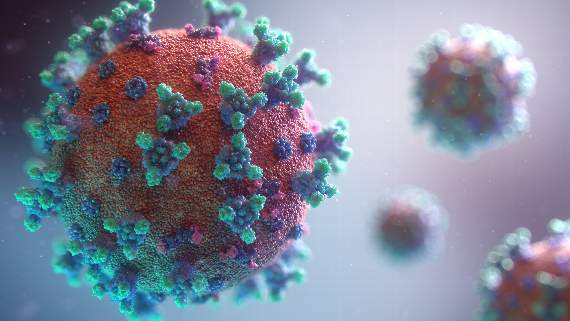The number of coronavirus cases confirmed across Devon and Cornwall has fallen by a quarter in the last week and to the lowest level since the start of December.
A total of 1,169 new cases were confirmed across the two counties in the last week as the total for the two counties now stands at 44,104– the lowest weekly total for nine weeks.
Devon also has the lowest infection rates of any upper tier authority in England, with Plymouth second and Cornwall third, and at a lower tier level, the seven lowest infection rates are all in Devon.
Government statistics show that 1,169 new cases have been confirmed across the region in the past seven days in both pillar 1 data from tests carried out by the NHS and pillar 2 data from commercial partners, compared to 1,547 new cases confirmed last week.
Of the 1,169 cases confirmed since February 5, 425 were in Cornwall, with 90 in East Devon, 68 in Exeter, 101 in Mid Devon, 24 in North Devon, 145 in Plymouth, 39 in South Hams, 105 in Teignbridge, 149 in Torbay, 11 in Torridge and 12 in West Devon
The latest positivity rates for tests carried out at 3 per cent in Cornwall, 1.9 per cent in East Devon, 1.7 per cent in Exeter, 5.5 per cent in Mid Devon, 1 per cent in North Devon, 2.2 per cent in Plymouth, 2.3 per cent in South Hams, 2.7 per cent in Teignbridge, 3 per cent in Torbay, 0.8 per cent in Torridge and 1.9 per cent in West Devon. Every single area has seen positivity rates fall since last Friday except Mid Devon.
In terms of infection rates per age range, case rates are highest in the 20-39 age ranges across Devon and Cornwall, with only South Hams and Torridge (the 40-59s) and Exeter (80+) having infection rates higher in different age groups. Infection rates though are falling in age groups, and in Torridge, infection rates for the over 70s, 5-19 and 25-34 year-old are all at 0, showing no-one in that age range has tested positive in the last week.
As of Tuesday morning, there were 324 patients occupying beds across the county after a positive test, down on the 403 as of the previous Tuesday, and patient numbers having fallen in all of Devon and Cornwall’s hospitals.
Devon’s figures are slightly inflated by the fact that they have been taking in patients from elsewhere in the country, including Somerset and Dorset, because in those regions, they are closer to capacity than Devon is.
In total, as of Tuesday, there were 58 patients at the Royal Devon and Exeter Hospital (down from 80 as of Jan 26), 57 at the Nightingale (up from 55), 35 at Torbay Hospital (down from 42), 92 in Derriford Hospital in Plymouth (down from 112), 8 at North Devon District Hospital (unchanged), and four in Devon Partnership NHS Trust units (up from 3) although not all patients are local given some have been transferred to the region from elsewhere.
The figure for the Royal Devon and Exeter Hospital of 58 patients is the lowest that they have been treating for nearly three months – when there were 55 patients on November 7.
But in Cornwall, the number of patients in hospital has risen slightly, up to 149 from the 143 as of last week.
And the number of patients in mechanical ventilation beds across the two counties is slightly up as well, with 20 in Derriford, 10 at the Royal Devon and Exeter, and seven in Torbay, up from 35 in total as of last Tuesday, while in Cornwall, the total has risen from 13 to 14.
The figures show the amount of patients in hospital following a positive COVID-19 test who are currently occupying a bed.
But not every patient would necessarily have been admitted to hospital due to COVID-19, with a number of patients either contracting the virus inside the hospital, or being admitted for unrelated reasons but subsequently testing positive asymptotically when given routine tests.
And as a percentage of total acute beds available, 2 per cent of beds in North Devon are occupied with Covid patients, 4 per cent in Torbay, 10 per cent in Plymouth, and 15 per cent in Exeter, all down on the figures as of last week, but Cornwall at 16 per cent is slightly up.
North Devon, Torbay and Plymouth have the lowest percentage occupancy rates anywhere in England, while at a partnership level, Devon is the lowest.
And based on patients, both covid and non-covid related, in adult critical care, as a share of total capacity last winter, every single hospital in Devon has a lower occupancy of capacity that last winter.
Figures from the Health Service Journal, whereby 100 per cent equals last winter’s capacity occupied, Derriford is at 90 per cent, Exeter at 92 per cent, North Devon at 75 per cent and Torbay at 70 per cent. Cornwall though is at 127 per cent.
In the last week, there have been 47 deaths in Devon and Cornwall hospitals of patients within 28 days of a positive Covid-19 test, with 23 in Cornwall, 12 in Plymouth, six in Torbay, five in Exeter and one in North Devon.
In terms of the latest MSOA cluster maps, that cover the period of specimen dates between February 1 and February 7, there are 73 areas of Devon and Cornwall with between 0-2 cases, up from 38 as of last Friday
The MSOA areas in each region with the highest number of cases are Kingsand, Antony & Maryfield (30), Axminster (12), Mincinglake & Beacon Heath and Pinhoe & Whipton North (both 7), Tiverton East (28), Barnstaple South and Roundswell & Landkey (both 5), Keyham, St Budeaux and Millbay & Stonehouse (all 12), Dartmouth (8), Ogwell, Mile End & Teigngrace (13), Shiphay & the Willows (20), Holsworthy, Bradworthy & Welcombe (5), and Hatherleigh, Exbourne & North Tawton (7)
It comes as Steve Brown, director of public health Devon, said that while the news that Devon has the lowest infection rates is good news, it is too soon for celebration.
He said: “Case numbers are continuing to fall in most parts of Devon, and that’s because people in the main are adhering to the national restrictions.
“We are seeing a slight increase in cases in Mid Devon, although case numbers there are still low – and far lower than the national average.
“But those Mid Devon numbers should be a reminder to show how easily cases can go up quickly as well as go down.”
Case rates are currently highest for those aged 20 to 39, but are falling in all age groups, and most rapidly in those aged 80 and over.
He added: “Please don’t be complacent or drop your guard, either in the workplace or indeed travelling to or from work.”
By Daniel Clark, loca democracy reporter




